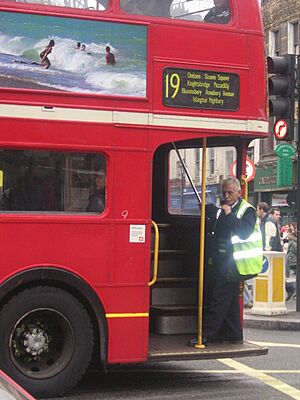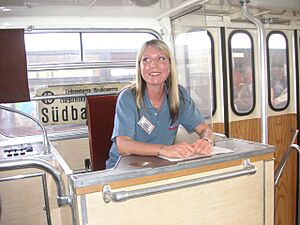Bus conductor facts for kids
Bus conductors were people who worked on buses, usually helping the driver and collecting fares from passengers. They were very common in many towns and cities, especially in the UK and Ireland, until the late 1970s and early 1980s. You might have heard them called "clippies" in the past.
Conductors were often needed because many cities used double-decker buses. Until the 1960s, these buses had engines at the front and a special design that separated the driver from the passengers. This meant the driver couldn't easily collect tickets or see everyone getting on and off. The conductor would communicate with the driver using bell codes. For example, two rings of a bell meant "ready to go!"
Many older double-decker buses had an open platform at the back where passengers would get on. Others had an entrance at the front. In both cases, a conductor was essential. They collected money for tickets and made sure passengers got on and off safely, especially on the buses with the open rear platform.
Contents
Why Did Bus Conductors Become Less Common?
In the late 1950s, new types of double-decker buses started to appear. These buses had their engines at the back and the entrance door was right by the driver. This new design made it possible for the driver to do everything.
From July 1966, rules in the UK changed. They now allowed only the driver to operate urban double-decker buses. This meant the driver could collect fares and manage passengers getting on and off. Some bus companies quickly started using these new "one-person operated" buses. Others took more time.
The UK government even offered money to bus companies that bought these new driver-only buses. This encouraged companies to switch away from the older buses that needed conductors. Because of this, the number of bus routes with conductors slowly went down throughout the 1970s. Older buses were replaced with newer models that only needed one person to operate them.
Where Can You Still Find Bus Conductors?
Bus Conductors in China
Even today, bus conductors are still very common on most buses in Beijing, China.
Bus Conductors in Britain and Ireland
By the early 1980s, bus conductors had mostly disappeared in most cities, except for London and Dublin. London was special because it continued to use its famous AEC Routemaster buses. These buses were perfect for London's busy streets. They were easy to steer, and passengers could get on and off quickly because the conductor collected fares.
The Routemaster buses were also very well-built and could be repaired easily. Plus, the "traditional red bus" became a famous symbol of London around the world. Even though most London buses became driver-only by the late 1980s, some routes in central London still used Routemasters and conductors until 2005.
However, over time, these Routemaster services were also changed to modern, driver-only buses. One reason for this was to make buses more accessible for people with disabilities. The last regular Routemaster bus service with a conductor stopped on December 9, 2005.
In the late 2000s, some new bus services in the UK tried bringing back conductors, like the FTR routes in York, Leeds, and Swansea. But by 2020, these services had also stopped using conductors.
Today, Stagecoach Strathtay still uses conductors on its Tayway service 73 in Scotland. However, they announced in September 2020 that they plan to stop using conductors on this service too. This is partly because of the COVID-19 pandemic and the move towards contactless payment.
Some special services, like the 'Exmoor Explorer' in Somerset, still use conductors on vintage open-top buses. Conductors also returned to London briefly in 2012 with the introduction of the New Routemaster. Their job was to help passengers with their Oyster cards and supervise the open platform. However, these conductors have since been removed, and these buses now run with only a driver.
Bus Conductors in Asia and Mauritius
In countries like India, Pakistan, Bangladesh, Qatar, and Sri Lanka, bus conductors are almost always on buses throughout the journey. Government bus conductors might use a bell, a whistle, or shout "right!" to tell the driver when to go. Private bus conductors often use whistles or just shout. It's also common for conductors to clap their hand firmly on the outside of the bus to signal the driver that everyone is on board.
Did you know that the famous Indian actor Rajinikanth used to work as a bus conductor before he became an actor?
In Mauritius, it's also very common to see both a bus driver and a bus conductor. The conductor's main job is to collect money and give out tickets to passengers.



